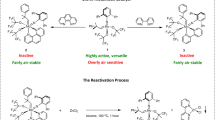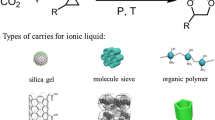Abstract
Metal oxide catalysts were studied for their selectivity for the production of a terminally unsaturated methyl ester, methyl 5-hexenoate (M5H), from a 6 carbon, 6-membered ring lactone, δ-hexalactone (DHL). A 15 wt% Cs/SiO2 catalyst had a selectivity of 55% to M5H. This selectivity was the highest of the metal oxide catalysts studied, which were Cs/SiO2, MgO, SrO, CeO2, ZrO2, Ta2O5, MgAl2O4, and a Mg–Zr mixed oxide. The Cs/SiO2 catalyst was utilized for the ring-opening of γ-valerolactone (GVL), a 5 carbon, 5-membered ring lactone. The catalyst was 88% selective to the terminally unsaturated methyl ester, methyl 4-pentenoate (M4P). Weight hourly space velocity studies determined that the unsaturated ester distributions remained constant and no C=C double bond isomerization occurred. Liquid phase transesterification reactions with DHL and methanol and nuclear magnetic resonance spectroscopy confirmed that DHL undergoes ring-opening transesterification to produce an ω-1 hydroxy methyl ester, methyl 5-hydroxyhexanoate (M5HH). Liquid phase transesterification reactions and thermochemistry calculations established that the equilibrium for GVL transesterification with methanol was favored towards the ring-closed lactone instead of the ring-opened hydroxy ester because of the decreased ring strain of GVL compared to DHL. The difference in terminally unsaturated methyl ester selectivity between GVL and DHL manifests from the difference in ring-strain energy. DHL passes through the M5HH intermediate as a result of greater ring strain, while the production of M4P from GVL most likely occurs through a direct, concerted mechanism.
Graphical Abstract








Similar content being viewed by others
References
Nikolau BJ, Perera MADN, Brachova L, Shanks B (2008) Plant J 54:536–545
Shanks BH (2007) ACS Chem Biol 2:533–535
Schwartz TJ, O’Neill BJ, Shanks BH, Dumesic JA (2014) ACS Catal 4:2060–2069
Schwartz TJ, Shanks BH, Dumesic JA (2016) Curr Opin Biotechnol 38:54–62
Bowen CH, Bonin J, Kogler A, Barba-Ostria C, Zhang F (2016) ACS Synth Biol 5:200–206
Dellomonaco C, Clomburg JM, Miller EN, Gonzalez R (2011) Nature 476:355–359
Cardenas J, Da Silva NA (2014) Metab Eng 25:194–203
Jez JM, Bowman ME, Noel JP (2002) Proc Natl Acad Sci USA 99:5319–5324
Chia M, Schwartz TJ, Shanks BH, Dumesic JA (2012) Green Chem 14:1850
Alonso DM, Bond JQ, Dumesic JA (2010) Green Chem 12:1493
Wettstein SG, Alonso DM, Chong Y, Dumesic JA (2012) Energy Environ Sci 5:8199
Horváth IT, Mehdi H, Fábos V, Boda L, Mika LT (2008) Green Chem 10:238–242
Mellmer MA, Martin Alonso D, Luterbacher JS, Gallo JMR, Dumesic JA (2014) Green Chem 16:4659–4662
Mellmer MA, Sener C, Gallo JMR, Luterbacher JS, Alonso DM, Dumesic J (2014) Angew Chem Int Ed Engl 53:11872–11875
Bond JQ, Wang D, Alonso DM, Dumesic JA (2011) J Catal 281:290–299
Bond JQ, Alonso DM, West RM, Dumesic JA (2010) Langmuir 26:16291–16298
Wang D, Hakim SH, Alonso DM, Dumesic JA (2013) Chem Commun (Cambridge) 49:7040–7042
Dorko CL, Ford GT, Baggett MS, Behling AR, Carmen HE (2014) Kirk-Othmer encyclopedia of chemical technology. Wiley, Hoboken, pp 1–19
Werle P, Morawietz M, Lundmark S, Sörensen K, Karvinen E, Lehtonen J (2008) Ullmann’s encyclopedia of industrial chemistry. Wiley-VCH Verlag GmbH & Co. KGaA, Weinheim
Market sand Markets (2014) 1,6-Hexanediol market by application (polyurethanes, coatings, acrylates, adhesives, unsaturated polyester resins, plasticizers, and others) and by geography (NA, Europe, Asia-Pacific, & ROW) - Trends and Forecasts to 2019, 2014
Oppenheim JP, Dickerson GL (2003) Kirk-Othmer encyclopedia of chemical technology. Wiley, Hoboken
Sridhar S, Carter RG (2001) Kirk-Othmer encyclopedia of chemical technology. Wiley, Hoboken
Beller M, Seayad J, Tillack A, Jiao H (2004) Angew Chem Int Ed Engl 43:3368–3398
Manzer L US6835849B2, 2004, 1.
Serrano-Ruiz JC, Luettich J, Sepúlveda-Escribano A, Rodríguez-Reinoso F (2006) J Catal 241:45–55
Aramendía MA, Boráu V, Jiménez C, Marinas A, Marinas JM, Navío JA, Ruiz JR, Urbano FJ (2004) Colloids Surf A 234:17–25
Ono Y, Hattori H (2011) Solid base catalysis, vol 101. Springer, Berlin
Brown JM, Conn AD, Pilcher G, Leito MLP, Meng-Yan Y (1989) J Chem Soc Chem Commun. https://doi.org/10.1039/C39890001817
Stedjan MK, Augspurger JD (2015) J Phys Org Chem 28:298–303
Boonphong S, Kittakoop P, Isaka M, Pittayakhajonwut D, Tanticharoen M, Thebtaranonth Y (2001) J Nat Prod 64:965–967
Li X, Sattler I, Lin W (2007) J Antibiot (Tokyo) 60:191–195
Barrow CJ (1997) J Nat Prod 60:1023–1025
Colmenares AJ, Durán-Patrón RM, Hernández-Galán R, Collado IG (2002) J Nat Prod 65:1724–1726
Acknowledgements
This material is based upon work supported by the National Science Foundation Engineering Research Center for Biorenewable Chemicals (CBiRC), under Award Number EEC-0813570. The authors would like to thank the Magnetic Resonance Facility in the Chemistry Department of the University of Wisconsin-Madison for use of the Bruker Avance III 500 gifted by Paul J. Bender. The use of facilities supported by the Wisconsin Materials Research Science and Engineering Center is also acknowledged (DMR-1121288). We thank Leo Manzer and Thomas Schwartz for helpful discussions about lactone ring-opening. We thank Heike Hofstetter for discussions about NMR analyses. Any opinions, findings, and conclusions or recommendations expressed in this material are those of the authors and do not necessarily reflect the views of the National Science Foundation.
Author information
Authors and Affiliations
Corresponding author
Rights and permissions
About this article
Cite this article
Brentzel, Z.J., Ball, M.R. & Dumesic, J.A. Selective Production of Terminally Unsaturated Methyl Esters from Lactones Over Metal Oxide Catalysts. Catal Lett 148, 3072–3081 (2018). https://doi.org/10.1007/s10562-018-2507-0
Received:
Accepted:
Published:
Issue Date:
DOI: https://doi.org/10.1007/s10562-018-2507-0




